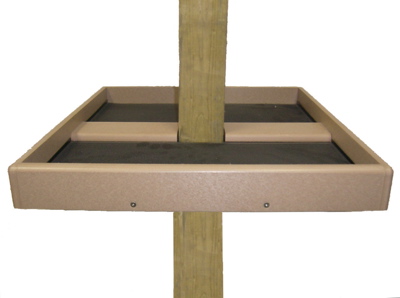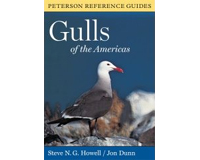-
Innovative Seed Tray for Posts
Offer your feathered friends more space to feed…
Invite new birds who may not even perch at your feeder with a seed tray. They’re excellent for eliminating ground mess, while saving your birdseed and money. Any type of food, from suet and seed, to mealworms and fruit treats may be fed on this type of platform.
This recycled seed tray is made from poly lumber, and is guaranteed to never crack, split, or fade. The innovative design allows you to place it below a hopper style, or other bird feeder that’s mounted on a 4×4 post. Removable trays make it simple to clean this great seed tray.
Recycled plastics help to keep containers and milk jugs out of landfills, and they’re less likely to aid in the spread of diseases as they are non-porous. This makes them easy to clean too.
-
Why is the BLM Allowed to do This?
OBAMA ADMINISTRATION ESCALATES ASSAULT ON WILD HORSES: 2,000+ MORE MUSTANGS TARGETED IN NEVADA
Ignoring public outrage, government hits milestone: number of wild horses in BLM warehouses exceeds those left on the rangeEastern Nevada (January 19, 2010) – Ignoring growing public outrage over the unnecessary mass roundups of wild horses, the Obama Administration has announced its next victims: 2,000 mustangs living in two herd management complexes in eastern Nevada. According to In Defense of Animals (IDA), the Bureau of Land Management (BLM)’s newest assault, when combined with the ongoing roundup of horses living in the Calico Mountain Complex in northwestern Nevada, will eliminate nearly 4,500 horses, or a quarter of the state’s estimated wild horse population.
The BLM recently announced that it is taking public comments on the next targets for capture and removal:
- 550 horses living in and near the Eagle Herd Management Area (HMA) in eastern Lincoln County (50 miles southeast of Ely), beginning mid-February and leaving only 100 horses in the 625,000 acre public lands complex; and
- 1,506 mustangs living in the Antelope Complex (east/southeast of Elko), leaving just 471 horses behind on more 1.3 million acres in a roundup scheduled for late summer/early fall.
“President Obama may go down in history for presiding over a deadly milestone for these living legends,” said William J. Spriggs of Buchanan Ingersoll and Rooney, which filed a pro bono lawsuit to stop the Calico roundup on behalf of IDA, ecologist Craig Downer and popular author Terri Farley. The case is ongoing in federal court.
“Under his watch, the number of wild horses stockpiled in government holding facilities has surpassed the number of mustangs left free and wild on the range. By reducing the number of horses to dangerously low numbers, the Obama Administration is placing the viability of these historic and unique herds at great risk,” Mr. Spriggs concluded.
Since December 28, the BLM has captured nearly 1,000 horses in the Calico Mountain Complex killing at least seven of them. That roundup proceeded despite a December 23, 2009 ruling by federal court Judge Paul Friedman questioning the legality of the BLM’s long-term holding facilities and suggesting that the BLM postpone the Calico roundup.
More information on the Eagle roundup is here. Follow news of the Calico roundup and other important wild horse news on IDA’s blog and get updates on Twitter
Wild Horse Facts:
· The Obama Administration plans to remove 12,000 mustangs from their Western ranges in FY 2010. Most of these horses will end up in government holding facilities.
· The number of wild horses in government holding facilities (35,000) now exceeds those left in the wild (33,000 by BLM estimates).
· The wild horse population today is smaller than in 1974 when the BLM conducted its first census after Congress protected the horses due to their dwindling numbers.
· Wild horses comprise a minute fraction (0.5 percent) of grazing animals on public lands, where they are outnumbered by cattle at least 200 to 1.
· The BLM manages more than 256 million acres of public lands. Cattle grazing is allowed on 160 million acres, while wild horses are restricted to 26.6 million acres of land that is shared with cattle.
· Since 1971 when Congress protected wild horses as “living symbols of freedom” and important parts of our national heritage, the BLM has removed over 200,000 horses from the range and taken away 20 million acres of wild horse habitat.
· The BLM frequently increases livestock grazing allotments after removing wild horses. Horses are also displaced for the benefit of other commercial users of public lands, including mining, oil/gas and other extractive industries.
- The Obama Administration proposes to spend up to 500 million tax dollars to purchase private lands in the Midwest and East to warehouse wild horses removed from public lands (which the taxpayers already own) in the West. In response to IDA’s lawsuit, U.S. District Court Judge Paul L. Friedman ruled that these holding facilities are likely illegal.
- The mustang has spent hundreds of years acclimating to the arid, rocky terrain of the west and their presence on that landscape is part of our national heritage. Not only are they ill-suited to the wet, lush Midwestern climate but their absence from the west is an affront to our cultural history.
###
In Defense of Animals is an international animal protection organization located in San Rafael, Calif. dedicated to protecting animals’ rights, welfare, and habitat through education, outreach, and our hands-on rescue facilities in Mumbai, India, Cameroon, Africa, and rural Mississippi.
-
Bird Field Guides-Handy at Home and Away
At home a handy bird book sits on the breakfast room table along with a small pair of binoculars. When time permits, which seems scare, or when the occasional rare bird visits the yard, I’ll pick up the field guide to try and identify the new species.
This week however, unexpected travels took me to a hospital that sits across the street from the bay in South Jersey. On one of many breaks from the Intensive care Room, I walked down to the bay to watch the birds-mostly sea gulls. Living in Georgia for the past 25 years or so, I don’t get to see the shore birds anymore, except for the annual beach vacation after Labor Day. Bird Field Guides would have allowed me to identify the different species of shore birds I was witnessing this sunny day. It would have likely taken my mind off of the sad situation at hand as well.

 Offer your feathered friends more space to feed…
Offer your feathered friends more space to feed… At home a handy bird book sits on the breakfast room table along with a small pair of binoculars. When time permits, which seems scare, or when the occasional rare bird visits the yard, I’ll pick up the field guide to try and identify the new species.
At home a handy bird book sits on the breakfast room table along with a small pair of binoculars. When time permits, which seems scare, or when the occasional rare bird visits the yard, I’ll pick up the field guide to try and identify the new species.